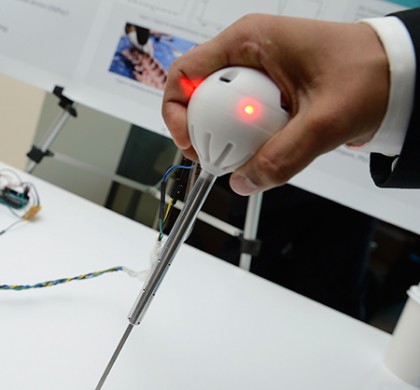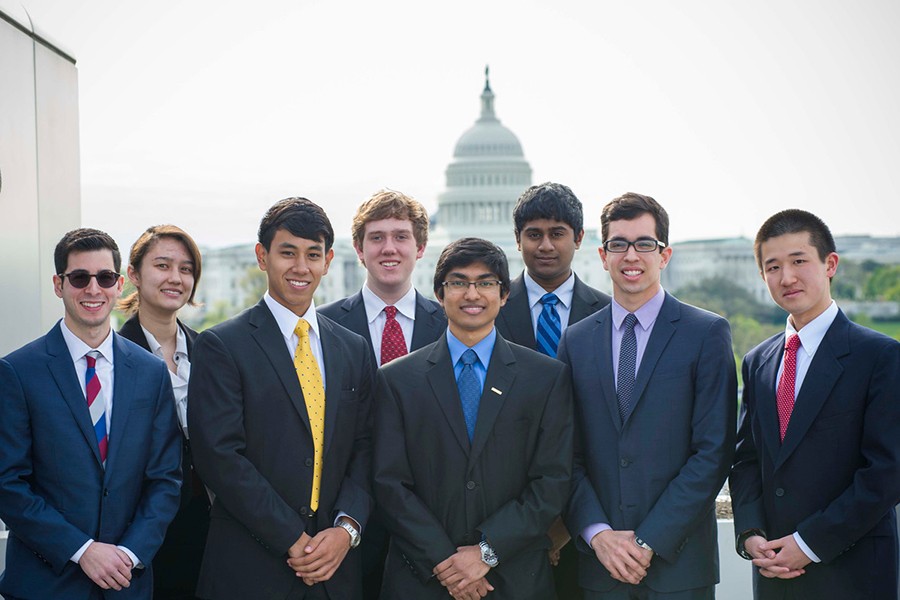A Johns Hopkins biomedical engineering student team has placed second in the undergraduate division of the Collegiate Inventors Competition for its AccuSpine probe, marking the third consecutive year that a Johns Hopkins team has been awarded a top prize in this challenge.

Image caption: The AccuSpine probe prototype
The winners were announced Monday during an awards ceremony at the U.S. Patent and Trademark Office in Alexandria, Va., after finalists presented their prototypes in a daylong exposition held by contest organizers Invent Now and the National Inventors Hall of Fame.
AccuSpine, developed under physicians Chetan Bettegowda and Sheng-fu Larry Lo of the university's School of Medicine, is a device that makes placement of screws during spinal fusion more accurate. The prototype, which already has been tested on cadavers, has garnered nearly $85,000 in prize money at innovation challenges this year. This latest award, coveted among undergraduate and graduate inventors, includes a $10,000 prize.
"We are very fortunate to have had the opportunity to participate in this distinguished competition," said Accuspine team leader Anvesh Annadanam, a senior studying biomedical engineering. Annadanam was a member of an earlier Johns Hopkins student team that won first-prize in the same competition in 2012 with a prototype called FastStitch.
"We are very thankful for the support of our biomedical engineering department," he said. "Our team will continue to work hard on the development of our device."
Each year, 500,000 spinal fusion surgeries are performed in the United States. These operations involve fusing vertebrae in the spine with metal screws and rods. However, the students say, screws are misplaced in roughly 20 percent of surgeries, leading to postoperative neurological or vascular complications.
"There's a hard bone layer that surrounds the vertebra," said Annadanam. "Our device tells surgeons when to stop so they don't breach that bone."
AccuSpine aims to enable safe and accurate pedicle screw placement by providing real-time feedback to the surgeon. It uses vibrations and flashing LED lights to warn when an imminent breach is detected. The advantages: It offers peace of mind in the operative outcome, a higher standard of care, and reduced intra-operative radiation exposure, said Annadanam.
The tool was designed by eight biomedical engineering undergraduates: Annadanam, Clay Andrews, Ravi Gaddipati, Luis Herrera, Adarsha Malla, Bradley Isaacs, Erica Schwarz, and Eric Xie. It began in July 2013 as part of a Department of Biomedical Engineering program within the Center for Bioengineering Innovation and Design.
The inventors have filed a provisional patent application on the device and intend to incorporate as a company. They plan to market the probe or license the technology to an existing company.
The student inventors' competition, in its 24th year, is sponsored by the Patent and Trademark Office and AbbVie Foundation. The Johns Hopkins team placed second among this year's seven finalists. In addition to the team award, a $2,000 award will go to the students' faculty advisor, Robert Allen, an associate researcher professor in the Department of Biomedical Engineering. This department is shared by the university's Whiting School of Engineering and its School of Medicine.
In the undergraduate division of this year's Collegiate Inventors Competition, The University of Wisconsin at Madison team placed first for Spectrom: Low-Cost, High-Precision, On-Demand Full Color 3-D Printing. SUNY Stony Brook University' team placed first in the graduate division for a skin patch that uses nanofibers to deliver a vaccine through skin.
The Johns Hopkins PrestoPatch team won first prize in the undergraduate division in 2013 for a prototype used during the administration of electric shocks to patients experiencing arrhythmia. The suturing tool FastStitch, another Johns Hopkins project that included Annadanam and Herrera, won the top prize in 2012.
Posted in Health, Science+Technology
Tagged biomedical engineering, patient safety, surgery, undergraduate research









